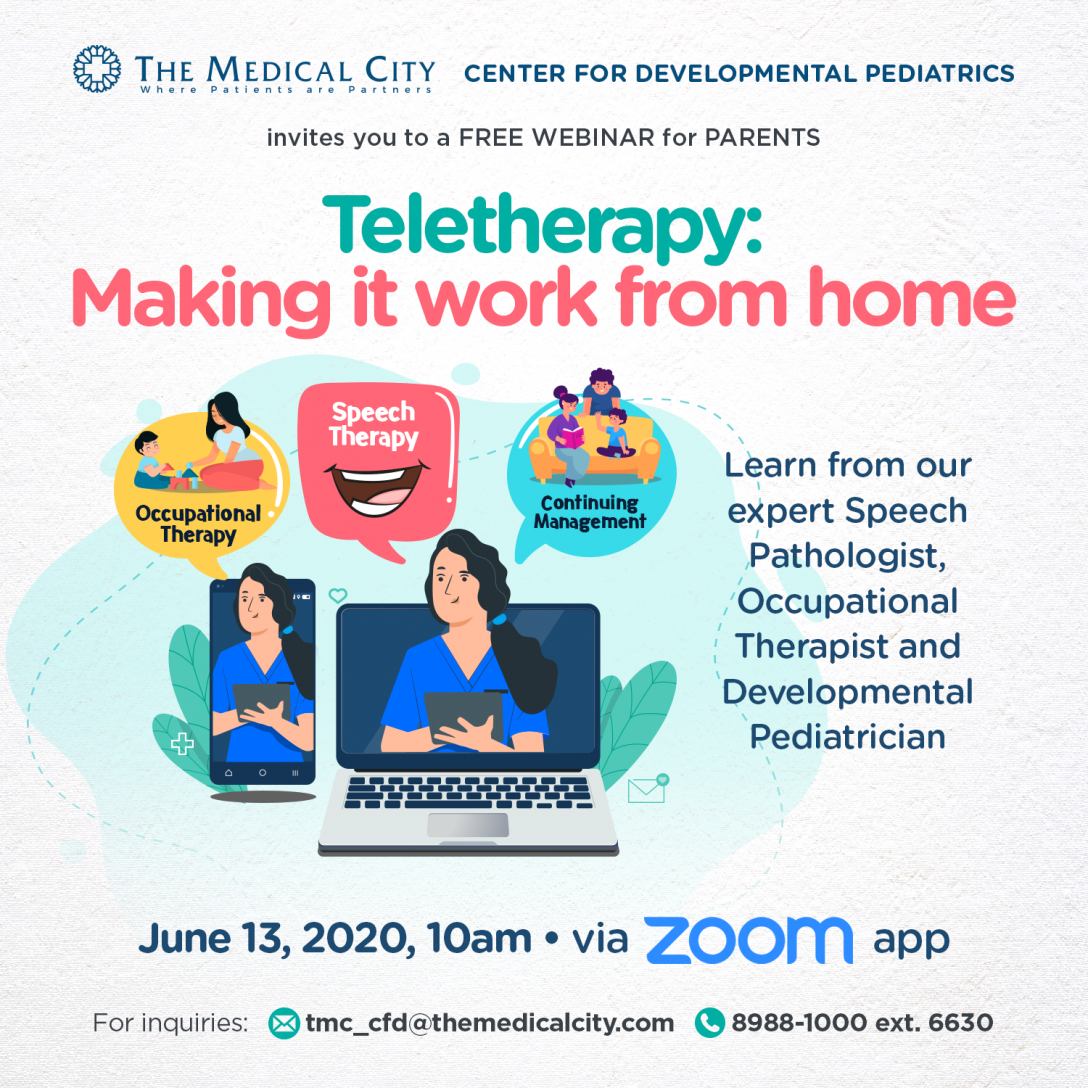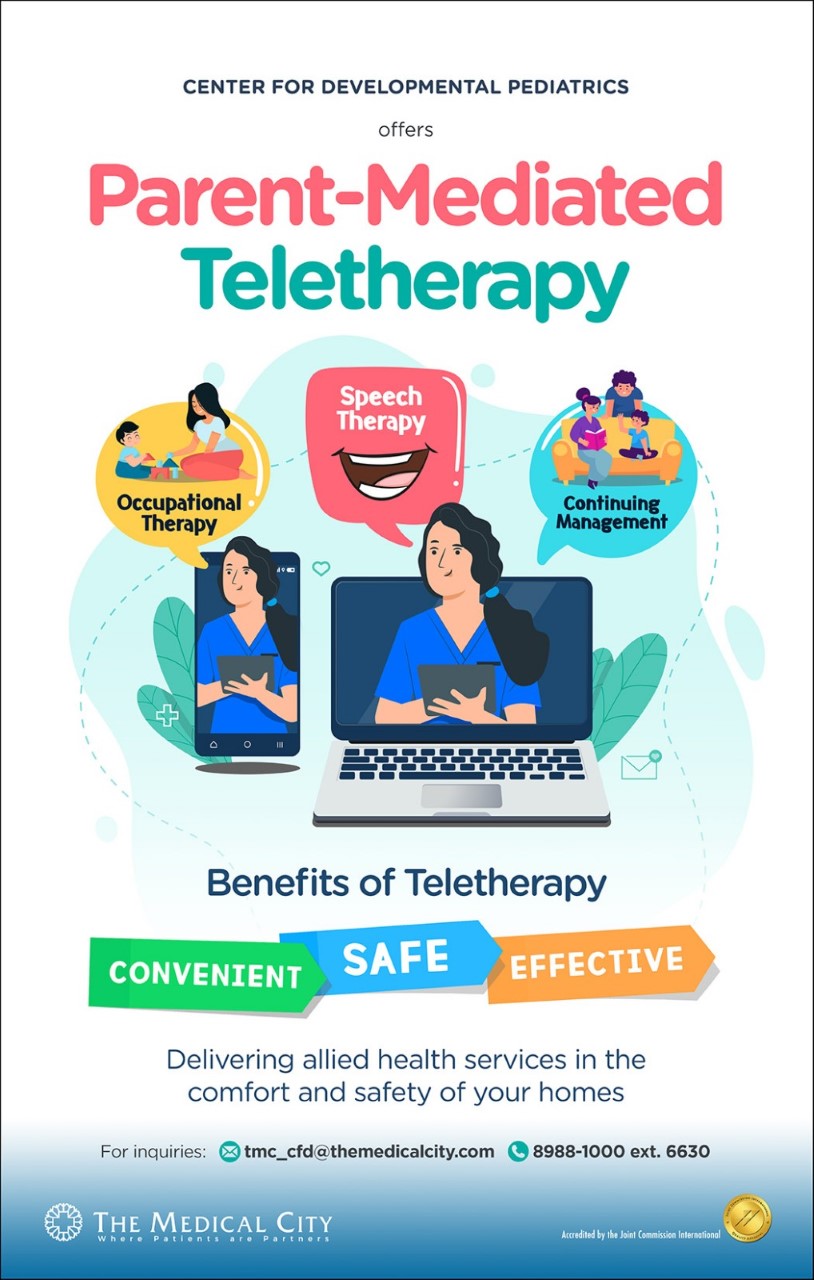Teletherapy: Making It Work From Home

Teletherapy or video counseling is therapy done through a live video connection, over the internet. Patients can get the same type of counseling they could receive in person, it’s just done through a computer.
Teletherapy is a service that has been offered in other countries since the late 1990s. However, in the Philippines, it was only during the advent of the COVID-19 pandemic that it was offered in order to provide necessary therapy for children while they stay at home.
Teletherapy or video counseling is therapy done through a live video connection, over the internet. Patients can get the same type of counseling they could receive in person, it’s just done through a computer. On 13 June 2020, The Medical City’s (TMC) Center for Developmental Pediatrics (CDP) conducted a webinar titled “Teletherapy: Making It Work From Home”. The discussion was led by developmental pediatrician Dr. Jacqueline Navarro, occupational therapist Mr. Glenn Gian Labrado, and speech pathologist Ms. Moira Bercades.
The discussion highlighted the benefits of engaging in teletherapy sessions. These benefits include convenience (no travel time), fewer missed appointments, reduced exposure to the virus, and increased parent involvement. It also provides an opportunity to work in the child’s home environment, making it easier for the child to retain learnings and skills developed during sessions.
Dr. Navarro shared that the CDP team has had plans of offering telehealth services since 2019. With the current situation in the country, the implementation of the program was expedited. Since disability will not go away and it is unknown when COVID-19 pandemic will end, it is only practical to adapt and ensure that the necessary health services are made available for children needing developmental and feeding screening and management.
The following recommendations were given to guide parents and caregivers:
1. Provide the optimal setup
- Stable internet connection
- Devices – what is used during sessions depends on the activity
2. Modify the environment
- Noise-free
- Appropriate lighting
- No clutter
3. Incorporate sessions into daily routine
- Create daily chance to work on goals
|
ACTIVITY |
LEARNING OPPORTUNITY |
|
|
|
|
|
|
|
|
By ensuring these recommendations are met, sessions will go smoothly and allow optimal results.
Facts on Teletherapy
In Labrado’s discussion, he said that teletherapy sessions can be delivered in synchronous, asynchronous, or hybrid formats. Synchronous Teletherapy makes use of interactive video or audio conferences that allow direct consultation between the therapist and the parent or primary caregiver.
Asynchronous Teletherapy, on the other hand, uses pre-recorded audio or video instructions from therapists which the parent can facilitate for the child. Consultations are conducted via email or as a teleconsult after the audio or video files have been utilized. Hybrid Teletherapy refers to a combination of direct consultation and pre-recorded instructions in executing therapy sessions.
Bercades talked about the modes of service delivery for teletherapy namely direct, consultative, coaching, and hybrid.
- Direct – the therapist addresses the child and facilitates the sessions
- Consultative – parent/primary caregiver communicates with the therapist regarding goal setting and problem-solving for home-based programs
- Coaching – instructions given by therapists are later facilitated by the parent/caregiver
- Hybrid – a combination of any of the three modes of delivery
To further emphasize the claims that teletherapy indeed works, Labrado and Bercades shared evidence supporting the application of teletherapy for speech and occupational therapy programs.
In speech therapy, evidence shows similar communication outcomes, increased parent satisfaction and fidelity, improved social communication skilla, reduced challenging behavior, and improved communication initiations and responses. As a result, it is now beginning to be an established practice in fluency disorders, dysphagia, and speech sound disorders in childhood.
In occupational therapy, studies show an increase in parent efficacy and child participation as well as significant gains in parent-identified goals.
The Role of Primary Caregivers in Teletherapy
In this parent-therapist partnership, the role of the parent or primary caregiver is given more emphasis rather than the role of the therapist. This is because they are the ones physically with the child, having more opportunities to facilitate learning and ensuring goals are met.
It is said that children make more progress when parents play an active role in this intervention. However, parents should also learn to let the child lead by providing opportunities to learn and allowing the child to decide on certain aspects of the sessions.
Bercades pointed out that as parents or primary caregivers, it is their role to modify assistance given to the child based on the feedback given by the therapist; provide accurate reports including wins and challenges, and apply therapeutic use of self (the use of affect and tone of voice to be more effective in communication) and adjusted based on the child’s engagement during the session.
Even without the presence of the therapist, parents and caregivers must ensure sessions are conducted by applying them in activities of daily living. This can help the child continue to progress. Teaching strategies to other members of the family empowers them and can result in better long-term outcomes.
Teletherapy and parent participation will have initial challenges but with the right mindset and guidance, it will provide the avenue for children to grow and develop to their full potential.
A Testament to the Effectiveness of Teletherapy
Though many are still hesitant to exchange a face-to-face therapy session with teletherapy, it is important to understand that online delivery of this service is still better than none when it comes to the management of certain developmental and behavioral concerns.
Towards the end of the event, Sarah Garrovilas, mother of three-year old Sandy, shared her experience on teletherapy which started two months ago.
“I had my reservations because we lacked equipment at home and the environment is different from the center,” Garovillas said.
They decided to try teletherapy given the recommendation of the developmental pediatrician. They made a weekly calendar for Sandy’s learning time and knew it was actually working when Sandy gained balance, control of her body movements, and spoke in constructive sentences.
“We’re seeing progress every week. We try to make her understand that there is a system we are adjusting to. Pag nasa bahay may learning time”, she added.
Garovillas highly recommended enrolling kids to teletherapy because, according to her, “It is best to be guided and every milestone will be worthwhile.”
The Medical City’s Center for Developmental Pediatrics
The Center for Developmental Pediatrics has modified its practices to adapt to the changing times. Measures to promote safety have been put in place for on-site visits. At the same time, telehealth services have been made available for the comfort and convenience of those they serve.

For inquiries, you may contact the Center for Developmental Pediatrics at 8-988-1000/8-988-7000 Ext. 6630 or email tmc_cfd@themedicalcity.com.